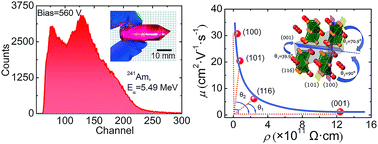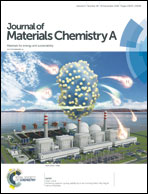Optical and electronic anisotropies in perovskitoid crystals of Cs3Bi2I9 studies of nuclear radiation detection†
Abstract
The halide perovskitoid compound Cs3Bi2I9 (CBI) has attracted considerable interest as a semiconductor because of its outstanding stability and reduced toxicity compared with lead-based halide perovskites. Here, we report the growth of nuclear radiation detection grade CBI bulk crystals (Φ 15 × 60 mm3) with a high resistivity of over 1010 Ω cm using a modified vertical Bridgman method. Because of their layered crystal structures we investigated the anisotropy in the optical and electrical properties using different crystal orientations. The CBI(001) sample exhibits a resistivity of ∼1012 Ω cm compared to ∼1010 Ω cm for the CBI(100) sample. This is due to the anisotropic mobility in the two crystallographic directions. Using 425 nm LED (∼200 mW cm−2) illumination CBI(001) possesses a superior optical response with a switching ratio of over 40, which is critically higher than that of CBI(100) (<2). Detectors of 2 mm thickness show a capability of detecting 241Am@5.49 MeV α particles, with good peak discrimination. A full width at half maximum (FWHM) of 32% was obtained under a bias of 560 V. Simultaneously, the electron mobility and mobility lifetime (μτ) were calculated to be 6.10 cm2 V−1 s−1 and 2.03 × 10−5 cm V−1, respectively. First-principles density functional theory calculations confirm the crystallographic anisotropy of the carrier effective masses. In addition, a significant X-ray sensitivity of 111.9 μC Gy−1 cm−2 for a CBI detector was observed, under 80 kVp X-rays at an electrical field of 450 V cm−1.



 Please wait while we load your content...
Please wait while we load your content...